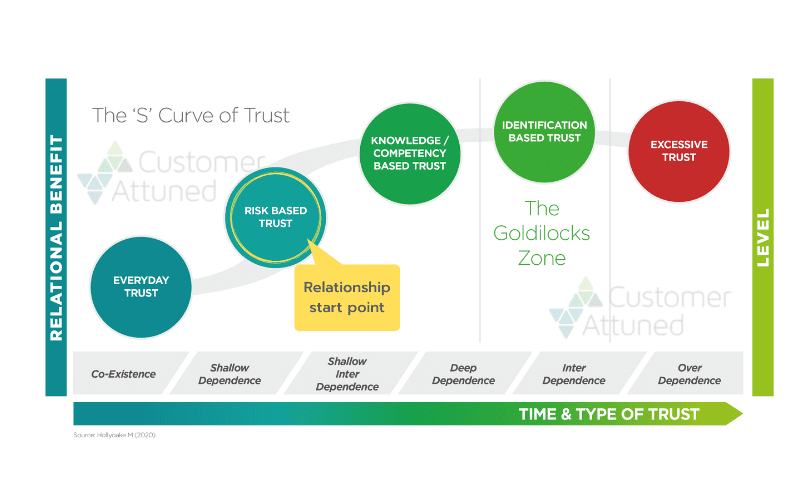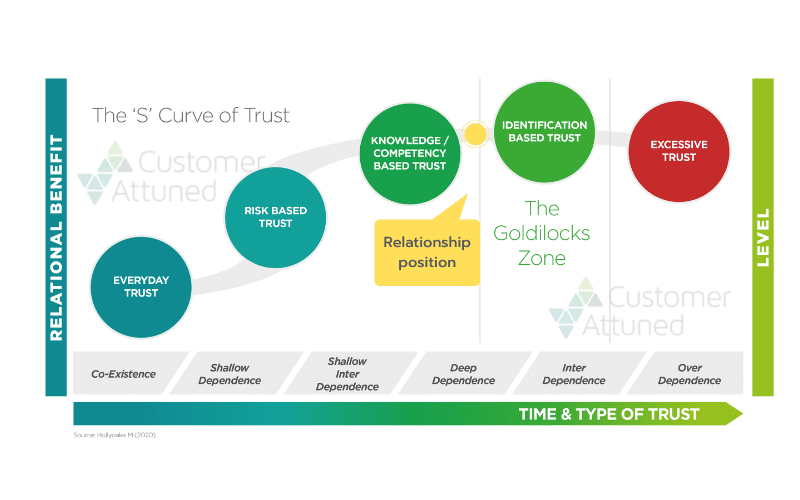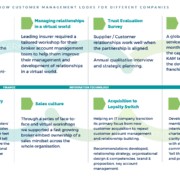What is Business-to-Business Trust?
What is Business-to-business trust?
It’s a willingness to make yourself vulnerable to another party in the expectation of positive outcomes.
Customer Attuned cofounder Dr Mark Hollyoake, describes what B2B trust means and how the application of trust principles benefit organisations.
An influential academic in the field defined it:
“Trust is a psychological state comprising the intention to accept vulnerability based upon positive expectations of the intentions or behaviour of another.”
(Rousseau et al., 1998)
It really makes sense when you consider it. If you do this and it results in a positive outcome you are more than likely to do it again and feel less vulnerable in the process.
Why is Business-to-Business Trust Important?
In a B2B context trust is slightly different due to the complexity of B2B relationships. We still see the vulnerability. However, a certain amount of reliance on both sides is required to enable positive outcomes as can be seen in the following definition of B2B Trust:
The willingness to be vulnerable to another party and the decision to engage in actions based upon an interpretation of their ability, credibility and the expectations of mutual value exchange over time. (Mark Hollyoake, 2020)
What it means: We are willing to work with you because we think you have the ability and credibility to develop value that we can both benefit from and do this more than one. If we do try it and it results in the value creation we expected, then we are more than likely to do it again. Overtime trust builds between both sides.
Should the result favour one side more than the other without mutual agreement, then mistrust or dissonance starts to creep in. Besides, should ability falter or credibility in the form of integrity or value decline, then this can also impact negatively.
TRUST BUILDING IN ACTION: A B2B Trust Case Study
Introduction
Here we take a look at the relationship between two large and complex business to business organisations:
- The supplier is a provider of outsourced technology, information and digital transformation capabilities;
- the client is a major UK utility company. The relationship is of significant value (hundreds of £millions).
The relationship had existed for over five years, with a wide scope covering the provision of contracted services across multiple functions, departments and sites.
This case covers a three to four year relationship development timeframe and longitudinal analysis.
The Challenge
Two key members of the senior leadership team from each side were dissatisfied with the relationship, and had come to the conclusion that something had to change. The following descriptors would have accurately described the relationship:
- Contractual: Running the relationship by the word of the contract
- Adversarial: Contesting each point of the contract when contravention seemed to have occurred.
- Little to no joint working or collaboration
Both parties recognised that they couldn’t carry on in the same way if they wanted to drive the change that was required and realise the potential for mutual value that had been identified as part of the contractual agreement. This situation was causing a material impact on performance and the relational dynamic through:
- Reduced ability to realise change
- Relationship by contract
- Time lag to realise locked-in cost
- Time lag on new tech, processes and systems adoption
- Inefficient and ineffective work practices
- Inability to realise identified and potential mutual value
Our trust team were asked to assist with recovering the relationship, and through the very act and intention of embarking on the journey they started the trust building process.
Sizing the Problem
We undertook qualitative interviews across both sides of the relationship at all levels: inter-organisational, inter-operations, inter-personal. A semi-structured interviewing technique was deployed, utilising the critical incident technique.
This highlighted a relational position on the trust ‘S’ curve (illustrated), and defined the start point for relational development and trust building.

At the same time an analysis was undertaken against known trust builders and diluters to establish what was working and what wasn’t working.
This formed the basis of an initial kick off joint workshop (the first time both sides’ full teams had been in the same room). The findings from the initial stage were shared with all of the stakeholders, validated and a trust development approach explored.
A Systematic Approach to Rebuilding Trust
Trust building is organisationally intertwined, if you change one area then it will have a knock-on effect elsewhere so you need an approach that addresses trust building in a systemic way.
A relational development plan was developed around 7 work streams emanating from the initial findings. Each work stream had a champion and cross functional / cross relational team. They reported progress to the senior leadership team relational board and wider teams on both sides. This ensured the relational intent stayed alive, relevant and re-enforced through all levels and both sides.
- Intention: The development of a relationship vison and charter.
- Ability: Cross relationship initiative to develop capability and competency in supplier areas of development need and to address those within the customer team.
- Credibility: Development of the internal customer team to propose and lead technical innovation across the business. The culture and way of working were addressed and further supported through the celebration of quick wins emanating from the programme. This was further enhanced through the identification and celebration of big prizes. External recognition provided confidence to the senior leadership relational board, through awards and external audit feedback.
- Joint working: Formal and informal sessions to share and develop within the customer team and then across the wider business. Exploring information and digital solutions co-created to address complex business issues and challenges.
- Mutual value:
- Supplier: access to additional areas of the business, enterprise-wide solutions and higher value annuity products / solutions.
- Customer: team expanded, responsibility extended and given access to the wider business for the development of future orientated digital solutions. Sister businesses exploring opportunities for help and support.
- Commitment: Demonstrated through resource allocation by both sides in terms of seniority, credibility and capability.
- Communication: Bespoke communication put in place for the programme: covering formal and informal – town hall events, message boards, newsletters, surveys, etc. Formal feedback of relationship audits to ensure everyone understood how things were going.
- Time: Contract renegotiated and renewed, with a 5-year extension.
Certain functions and areas of the relationship worked better than others with trust building moving ahead on the ‘S ’curve. Where change, entrenched behaviours and attitudes were the most difficult to realise elements of mistrust crept in through dissonance. These were addressed through effective; role and behaviour modelling, capability development and explanation of how trust develops and / or fails in a B2B environment
Outcomes
The relationship continues to go from strength to strength, entering into a collaborative partnership in some areas.
The supplier now holds up this relationship as a best practice example, having received numerous internal awards and recognition.
The relationship strength developed a perspective that made contract renewal and extension a given.
The supplier side of the relationship has grown into additional areas of the organisation developing the customers business partnership function in the process. This has opened up further relational opportunities in terms of:
The customer accessing specialised technology solutions, new ways of working and technological innovation. Providing increased efficiency, effectiveness, data and information management. This enabled greater insight and value add into process and systems efficiency.
The supplier accessing additional areas of the organisation, providing greater depth, breadth and embedded relationship. Providing new users, extended services and enterprise wide solutions.
The technological development that has been achieved has also enabled the customer to leverage their expertise to others for mutual value benefit.

The relationship has far higher levels of demonstrable trust, enabling technological transformation and mutual benefit gain.
The relationship is also in a position to offer advice and expertise to others in the sector around relational management, technical adoption, innovation and co-creation.
As a business leader, what should I do?
- Be clear about the level of vulnerability you can manage and risk you can bear for your key relationships.
- Find out the level of trust that exists in your different customer segments, including your key (80:20) relationships
- Show intent to the team, your customers and organisation around the development of those relationship that offer the potential to develop through trust building.
Obviously, its’ a lot more complex than this, however through laying down a business-to-business trust foundation you can explore trust building. If you would like to know more about changing the culture of your organisation to develop B2B trust in all your strategic client relationships.
Please note that this case study is based on an actual on-going relationship that due to confidentially, cannot be named, quoted, or performance numbers supplied.
In my next post I explore how trust could develop in a B2B relationship and enable you to mentally place some of your key relationships.
![]()
Is business-to-business Trust an issue in your company? Then talk to us – let us help you build Trust into your ways of working.
Follow Dr Mark Hollyoake on Twitter
- Leap of Faith by Dr Mark Hollyoake featured in the Journal of Sales Transformation - May 13, 2024
- Stop hiding behind your computer and get out to see your customers! - March 6, 2024
- B2B Trust Research: What are Boundary Spanners? - January 31, 2024






